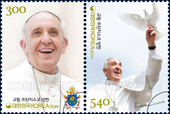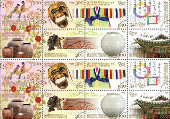-
 Korea.net's 24-hour YouTube channel
Korea.net's 24-hour YouTube channel- NEWS FOCUS
- ABOUT KOREA
- EVENTS
- RESOURCES
- GOVERNMENT
- ABOUT US
The great giant reptiles of the past have never co-existed with humans. Since they are of a monstrous size and yet can no longer be seen, they commonly trigger our curiosity about the past. Universally, dinosaurs are highly interesting animals, and Korea is no exception. Korea Post recently produced three editions of special postage stamps called "The Age of the Dinosaurs."
The first of the dinosaur series has illustrations of the carnivorous herrerasaurus and coelophysis and of the plant-eating plateosaurus and riojasaurus. They are from the Triassic Period, roughly 250 to 200 million years ago, the earliest third of the larger Mesozoic Era (roughly 250 to 66 million years ago), when dinosaurs first appeared.
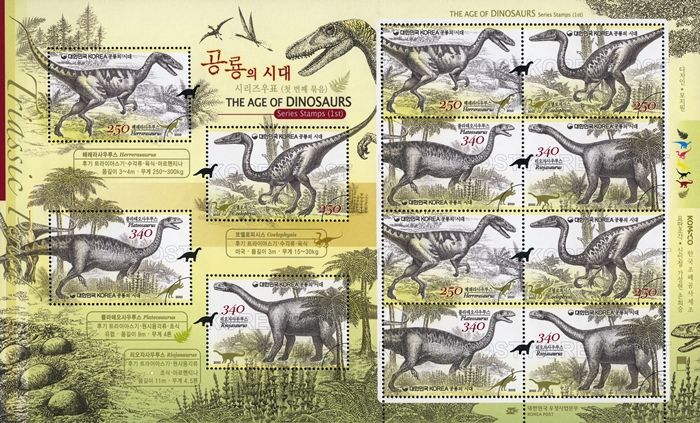
Korea Post's first edition of the "Age of the Dinosaurs" stamp series features the herrerasaurus (no. 2753), the coelophysis (no. 2754), the plateosaurus (no. 2755) and the riojasaurus (no. 2756). (Image courtesy of Korea Post)
The second series features dinosaurs from the Jurassic Period (roughly 200 to 145 million years ago), the middle third of the Mesozoic Era. Large reptiles roamed the land, while ammonites ruled the seas. Gymnosperms, like ginkgo trees, and cycad trees were commonly seen. Since dinosaurs and ichthyosaurs prospered during those times, it has been nicknamed the Era of Dinosaurs. Late in the Jurassic Period, the archaeopteryx, a prehistoric ancestor of birds, emerged. The stamp series features the herbivorous scelidosaurus and stegosaurus and the carnivorous allosaurus and dilophosaurus.
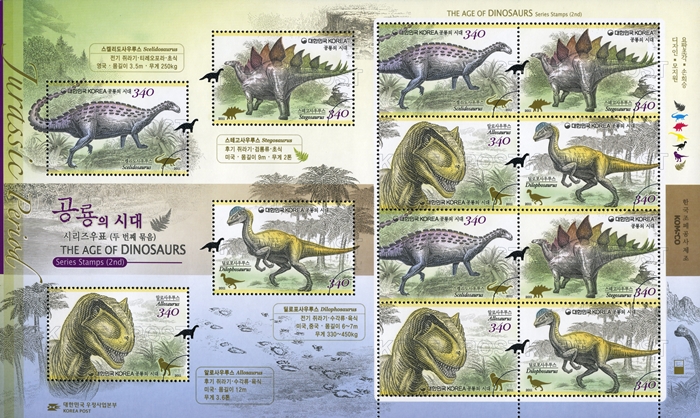
The second edition (2011) of the "Age of the Dinosaurs" stamp series features the scelidosaurus (no. 2810), the stegosaurus (no. 2811), the allosaurus (no. 2812) and the dilophosarurus (no. 2813). (Image courtesy of Korea Post)
The third and final series of stamps features dinosaurs from the Cretaceous Period (from about 145 to 66 million years ago), the last period of the Mesozoic Era. Herbivores like the pachycephalosaurus and the protoceratops, carnivores like the tyrannosaurus and omnivores like the oviraptor were dominant during these times.
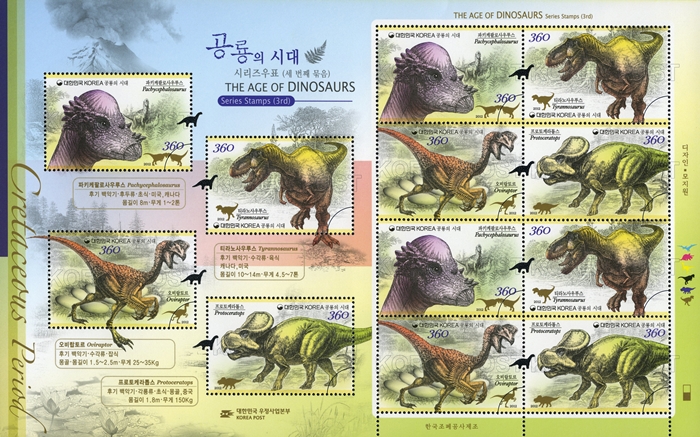
The third edition (2012) of the "Age of the Dinosaurs" stamp series features the pachycephalosaurus (no. 2878), the tyrannosaurus (no. 2879), the oviraptor (no. 2880) and the protoceratops (no. 2881). (Image courtesy of Korea Post)
"I wasn't able to draw these solely based on my imagination and creativity. I had to reference many books and photos in order to do this," said designer Mo Jiwon, the artist who illustrated all three stamp series.
"I especially appreciate the fact that many children adore these series."
By Wi Tack-whan, Paik Hyun
Korea.net Staff Writers
*Aforementioned stamps are available for purchase here. http://www.koreastamp.go.kr/
whan23@korea.kr










